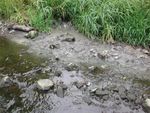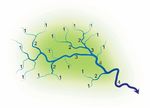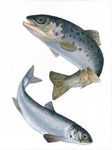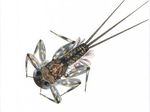The Importance of the Small Stream Network: An Introduction - University ...
←
→
Page content transcription
If your browser does not render page correctly, please read the page content below
The Importance of the Small Stream Network: An Introduction What are Small Streams? Small streams have been defined in many different ways but they are generally considered to lie within the headwaters of rivers extending only a few kilometres from their source. Most are therefore first or second- order (Strahler) streams (see Fig. 1) with small catchment areas and narrow channel widths (generally 70%) volume of water to downstream river reaches and lakes, where the water becomes available for abstraction. Control the Supply & Transport of Water & Nutrients Small streams capture flood water and regulate flow downstream. They may contribute to groundwater recharge, providing hydrological connectivity between terrestrial and downstream aquatic ecosystems, controlling the transport of sediment and nutrients (nitrogen, N, and phosphorus, P) as well as water between river and land, and
playing a vital role in the supply and transport of water and nutrients to the downstream river network and its
floodplains.
Their large benthic surface area relative to the overlying water volume, the close contact and exchange of water
within the hyporheic zone, combined with their large spatial extent mean that headwater streams can be important
‘hotspots’ for nutrient and organic matter processing within river catchments.
Retention and cycling of P and N in headwater streams provides an important ‘ecosystem service’, by transforming
and regulating downstream delivery of nutrients and modifying their form and timing of delivery in ways that can
help reduce ecological impacts on downstream receiving waters.
Spawning & Nursery Habitat for Salmonids
A number of fish species (e.g. eels) can be found in small streams but they are best
known for the important spawning habitat they provide for brown trout and salmon.
The juveniles of trout can spend several years in these streams before migrating
downstream where they become the catchable fish that support angling.
Support High Catchment & Regional Biodiversity
The aquatic biota of small streams include species that are
unique to the upper part of the river network, species that occur
there but also in larger rivers, species that move into
headwaters seasonally and those that migrate there to
complete particular life history stages (e.g. salmonids for spawning). Small streams may
individually support naturally low (• Vulnerability to environmental change:
Increasing prevalence of droughts and extreme summer low flows exacerbates the low baseflow dilution capacity
of headwater streams. Greater magnitude and frequency of extreme high flows and floods promote stream
scouring and reduce nutrient retention capacity in headwater streams. They also promote greater mobilisation
of ‘legacy’ nutrient stores within the catchment, and increase the loadings of carbon and other nutrient inputs
from terrestrial stores. High flows can result in increased stream-bank erosion and delivery of sediments from
soil disturbance associated with agriculture and forestry.
Key review papers for further information
J. Biggs, S. von Fumetti, M. Kelly-Quinn (2017). The importance of small waterbodies for biodiversity and
ecosystem services: implications for policy makers. Hydrobiologia 793, 3-39 (doi: 10.1007/s10750-016-3007-0)
W. D. Riley, J. Bigg,s A. L.Collins, H. P. Jarvie, J. I. Jones. M. Kelly-Quinn, S. J. Ormerod, D. A. Sear, R. L.Wilby S.
Broadmeadow, C. D. Brown, P. Chanin, G. H.Copp, I. G. Cowx, A. Grogan. D. D.Hornby, D. Huggett & G. M.
Siriwardena (2018). Small Water Bodies in Great Britain and Ireland: Ecosystem function, human-generated
degradation, and options for restorative action. Science of the Total Environment 645, 15, 1598-1616. Open
Access : https://doi.org/10.1016/j.scitotenv.2018.07.243
Introducing SSNet
-Managing the small stream network for improved water quality, biodiversity and
ecosystem services protection
Considerable knowledge gaps relate to many of the aforementioned benefits that small streams provide. In addition
to this, water pollution problems in the small stream network affect water quality downstream and are likely to limit
our ability to achieve the objectives of the Water Framework Directive.
SSNet is an EPA-funded research project led by researchers in University College Dublin with partners in Trinity
College Dublin, the Centre for Ecology and Hydrology and Queen Mary University of London in the UK.
The overall objective of the research is to build a science-informed knowledge base on the role of small streams in
water quality, biodiversity and ecosystem services protection to inform policy, measures and management options
to meet the WFD objectives and other regulatory targets.
The project will collect new data to
• Determine the effects of nutrient processing, cycling and export of nutrients in headwaters on nutrient status
further downstream.
• Build an integrated understanding of the physical character and dynamics (hydromorphology) of headwater
streams across Ireland.
• Determine the contribution of small streams to catchment biodiversity and the role of hydromorphology and
hydrochemistry in controlling their biodiversity potential. One of the tasks looks to the future and the
potential for using emerging DNA tools in biodiversity and water quality monitoring. This is important given
current developments in this area and the challenges of monitoring the extensive small stream network. In
this regard we will also explore options for increased engagement of citizen science in monitoring the physical
and ecological health of small streams
• Model the level of intervention in the small stream network required to have a measurable effect throughout a
catchment on both water quality (N, P & sediment) and flows, biodiversity protection and overall
delivery/maintenance of ecosystem services.
• Explore options for increased engagement of citizen science in monitoring the physical and ecological health of
small streams.
• Make recommendations for the management of the small stream network.
Follow us on Twitter @SSNetResearch and on our website: www.ucd.ie/ssnet
Contact for further information: mary.kelly-quinn@ucd.ieYou can also read
























































